the place where Paleontology and Paleoanthropology meets Philately
Canada
Dinosaurs and other prehistoric animals, fossils and fossil-found
places, Natural History Museums on stamps and postmarks of Canada
| << previous country | back to index | next country >> |
Contents:
- Country overview
- Philately of Canada
- Official stamps of Canada related to Paleontology
- Other stamps of Canada to consider
- Postal stationery of Canada related to Paleontology
- Commemorative postmarks of Canada related to Paleontology
- References
- Acknowledgements
Canada is a country in the northern part of North America. Its ten provinces and three territories extend from the Atlantic to the Pacific and northward into the Arctic Ocean, covering 9.98 million square kilometers, making it the world's second-largest country by total area and the fourth-largest country by land area.
Canada's border with the United States is the world's longest land border.
Canada is sparsely populated, the majority of its land territory being dominated by forest and tundra and the Rocky Mountains; about four-fifths of the country's population of 35 million people live near the southern border. The majority of Canada has a cold or severely cold winter climate, but southerly areas are warm in summer.
Canada is a country very rich in fossils, with many discoveries of dinosaurs and other prehistoric organisms. The fossils range in age from Precambrian stromatolites to Pleistocene Mammals. Many fossil-found paces and natural history museums are there. [R1]
The early postal and philatelic history of Canada actually started in the individual territories that were later joined together to form the Dominion of Canada. Before Canadian confederation, the colonies of British Columbia and Vancouver Island, Prince Edward Island, Nova Scotia, New Brunswick and Newfoundland issued stamps in their own names. [R2]
 |
 |
| The first stamp depicting an animal - Canada 1851, MiNr: 2, Scott 1. | Hidden date on dinosaur stamp of Canada 1993. |
In 1851, Canada issued the first postage stamp of the world with the image of an animal. This stamp featured a beaver - a national symbol of Canada.
Beginning in 1935, a hidden date was included in the design of many Canadian stamps.
Since 1974, all Canadian stamps have carried the date of the stamp's design, along with the copyright symbol, to show that the design belongs to Canada Post.
You would need a magnifying glass to see some of the dates. Click on the image on the right, to try to see the date on the dinosaur (Albertosaurus) stamp of Canada 1993
Nowadays, Canada issues 50-100 stamps per year of various topics related to the country: fossils, dinosaurs, prehistoric animals and fossil found sites have been shown on many stamps of the country. One unique feature of the Canadian Post is the large number of permanent pictorial cancels that they have produced.
These cancels are available at various post offices across the country, the list of available cancels can be found at the website of Canadian Post.
However, over time, some of the handstamps used to apply postmarks to the covers are damaged or even stolen – so the postmark is might be not available at a local post-office. Some postmark are replaced by new with slightly different design, as "Dinosaur Capital of the World" postmark from Drumheller. To get canceled letter, send stamped envelope and a cover with proper postage inside a stamped envelope addressed to the "Postmaster", followed by the name and full address of the post office. Some of these postmarks depict fossils and prehistoric animals on them.
Official stamps of Canada related to Paleontology: fossils, dinosaurs and other prehistoric animals
| 29.08.1986 "Exploration of Canada" | 01.10.1986 "Exploration of Canada" - CAPEX 87 | 22.03.1989 "Exploration of Canada" |

|
 |
 |
| 12.07.1990 "Prehistoric Life in Canada (I), The Age of Primitive Life" | 05.04.1991 "Prehistoric Life in Canada (II), The Age of Primitive Vertebrates" | 01.10.1993 "Prehistoric Life in Canada (III), The Age of Dinosaurs" [1] |
 |
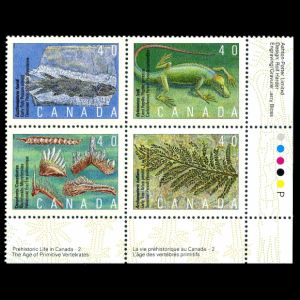 |
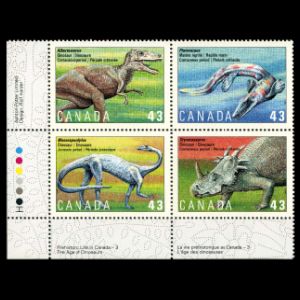 |
| 26.09.1994 "Prehistoric Life in Canada (IV), The Age of Mammals" | 28.07.1998 "Scenic Highways" | 14.04.2014 "100th anniversary of the Royal Ontario Museum" |
 |
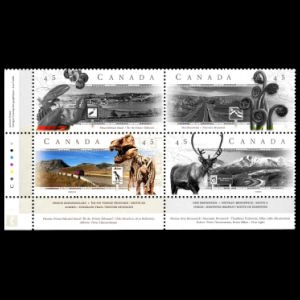 |
 |
| 14.04.2014 "100th anniversary of the Royal Ontario Museum" (self adhesive) | 13.04.2015 "Dinosaurs of Canada (I)" |
|
 |
 |
 |
| 26.05.2016 "Dinosaurs of Canada (II)" | ||
 |
 |
|
Notes:
[1] On October 10, 1993, only three month after release of "Jurassic Park" movie, three commonwealth countries: Australia, Canada and New Zealand issued dinosaur stamps.


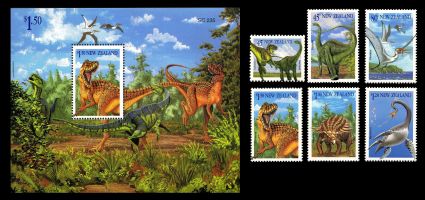
Other stamps to consider: fossil found places, Natural History Museums
| 17.12.1999 "Millennium" | 31.03.2014 "UNESCO World Heritage Sites" (self adhesive)[O2] | 31.03.2014 "UNESCO World Heritage Sites" [O2] |
 |
 |
 |
| 03.07.2015 "UNESCO World Heritage Sites" (design error) [O3] | 03.07.2015 "UNESCO World Heritage Sites" (design error), self-adhesive [O3] | 21.08.2015 "UNESCO World Heritage Sites" (corrected edition) [O3] |
 |
 |
 |
| 21.08.2015 "UNESCO World Heritage Sites" (corrected edition), self-adhesive [O3] | 16.01.2017 "UNESCO World Heritage Sites" [O4] | 16.01.2017 "UNESCO World Heritage Sites" [O4], self adhesive |
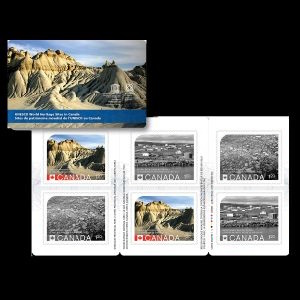
|
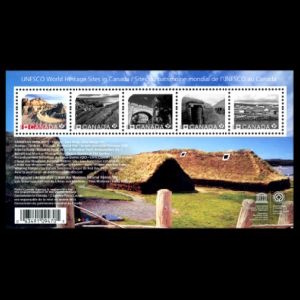 |
 |
Notes:
[O1] The first stamp on the Mini Sheet is dedicated to IMAX movies. Tyrannosaurus, perhaps from Jurassic Park movie is depicting on the middle of the stamp.
[O2] Fossil found site: Joggins Fossil Cliffs
and Miguasha National Park are depicted on UNESCO World
Heritage Sites stamps from 2014
 Nearly 400 million years ago, today’s Miguasha National Park,
Quebec(right) on the Gaspé Peninsula was once a tropical estuary.
The fossil beds of the Escuminac Formation, exposed in a seaside cliff provide a rare portrait
of Devonian life – including 21 species of fish fossils that have made Miguasha famous.
Nearly 400 million years ago, today’s Miguasha National Park,
Quebec(right) on the Gaspé Peninsula was once a tropical estuary.
The fossil beds of the Escuminac Formation, exposed in a seaside cliff provide a rare portrait
of Devonian life – including 21 species of fish fossils that have made Miguasha famous.
Nearly 200 fossil species found in the Joggins Fossil Cliffs(left) reveal the world’s most complete record of terrestrial life from the Pennsylvanian Period (the Coal Age), over 300 million years ago. It is possible to find here some of the earliest fossilized reptiles. These reptiles were some of the earliest amniotes, animals that lay shelled eggs – that allowed reptiles to lay eggs away from water. More info is here
|
[O3] Fossil found site: Dinosaur Provincial Park,
in the badlands of southeastern Alberta, contains some of the most important fossil
discoveries of more than 40 dinosaur species dating back to the Late Cretaceous Period,
75 million years ago.

On July 3, 2015 Canada Post launched the third set of stamps of UNESCO World Heritage sites in Canada series. On July 7, Officials at Canada Post issued a recall on a stamp featuring Dinosaur Provincial Park, a UNESCO World Heritage Site, because of a big problem. The error comes from the image used on the stamp, which is of a set of hoodoos (left), a rock formation found in the provincial park, located just north of Brooks, Alberta. The problem is that the image on the stamp is actually of hoodoos that found east of Drumheller, a community about an hour and a half northwest of Brooks. Canada Post apologized for the error and recalled the stamps from all Canadian Post Offices so they could be destroyed. A new stamp with the correct picture was issued on August 21st (on the right above). More info is here
|
[O4] Fossil found site: Dinosaur Provincial Park in Alberta and Mistaken Point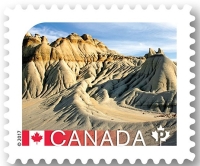

The first stamp on the mini sheet shows Dinosaur Provincial Park in Alberta (the same design as in 2015). Dinosaur Provincial Park is known for its remarkable fossil specimens that represent every known group of Cretaceous dinosaurs, as well as its impressive area of virtually undisturbed badlands and riparian (riverside) habitat. At Mistaken Point (the second stamp on the mini sheet), the rugged coastal cliffs host the oldest known collection of large fossils in the world, marking the world’s first appearance of large, biologically complex organisms. At Mistaken Point (the second stamp on the mini-sheet), the rugged coastal cliffs host fossils of the primitive animals of the Ediacaran fauna. The Ediacaran fauna includes the first large, biologically complex organisms that may be related to animals. |
Postal stationery of Canada related to Paleontology: fossils, dinosaurs
| 14.04.2014 "100th anniversary of the Royal Ontario Museum" | ||
 |
|
|
Official postmarks of Canada related to Paleontology: dinosaurs and other prehistoric animals.
Legend is here| 1989 "Tyrrell museum of Paleontology" [Sp] [DU] | 12.07.1990 "Prehistoric Life in Canada (I), The Age of Primitive Life" [FDC] | 05.04.1991 "Prehistoric Life in Canada (II), The Age of Primitive Life" [FDC] |

|
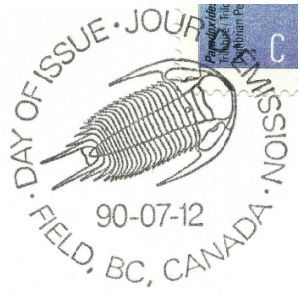 |
 |
| 05.04.1991 "Fossil fish from Miguasha fossils" [Sp] | [FDC] [C2]14.05.1993 "Dinosaur world tour" [Sp] | 01.10.1993 "Prehistoric Life in Canada (III), The Age of Dinosaurs" |
 |
 |
 |
| 16.10.1993 "Collector's show in Montreal" [Sp] | 26-28.11.1993 "Collector's show in Montreal" [Sp] | 26.09.1994 "Prehistoric Life in Canada (IV), The Age of Mammals" [FDC] |
 |
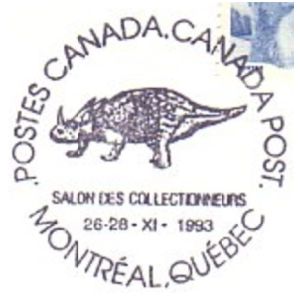 |
 |
| 22.10.1994 "Collector's show in Montreal" [Sp] | 29-30.1994 "Royal BC Museum" [Sp] | 05.07.1999 "Home of Big Bert" [PM] [C3] |
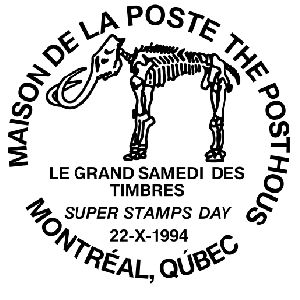 |
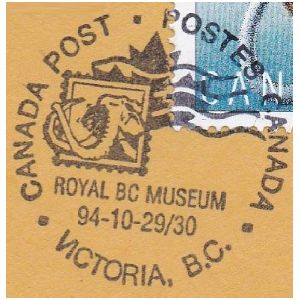 |
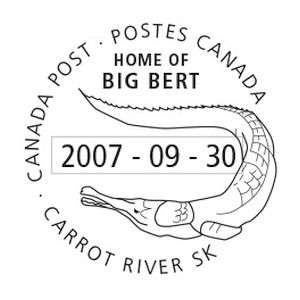 |
| 22.07.2001 "Parrsboro" [PM] | 09.10.2001 "Drumheller: Dinosaur capital of the world" [PM] [C2] | 31.12.2003 "Plesiosaur from Herschel" [PM] |
 |
 |
 |
| 30.04.2004 "National Park Miguasha" [PM] | 13.04.2015 "Dinosaurs of Canada (I)" [FDC] | 13.04.2015 "Home of Scotty the T. rex" [Sp] |
 |
 |
 |
| 20.05.2015 "The plesiosaurus" [Sp] | 26.05.2015 "Drumheller: Dinosaur capital of the world" [PM] [N] [C2] | 26.05.2016 "Dinosaurs of Canada (II)" [FDC] |
 |
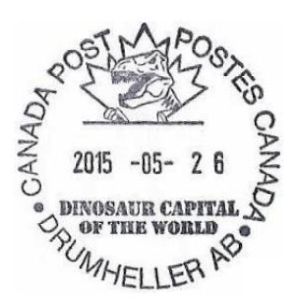 |
 |
Notes:
[C1] There are some FDC with an extra postmark that shows Tyrannosaurus from Alberta. However, this postmark does not cancel a stamp and has “Philatelic Canada” instead of “Canada Post”. A similar postmark was used on another FDC from 1990, but without any date on it.

|
 |
 |
 |
As seen above, it is very likely this postmark is not official but instead a personalized postmark designed by some philatelic club, dealer or collector for decorative purposes only.
[C2] New design of postmark from 2001 "Dinosaur Capital of the world" from Drumheller, new postmark is larger and uses different font
 |
 |
[C3]
 |
 |
Tha animal on the postmark is Big Bert is the world's most complete Terminonaris robusta crocodile skeleton; discovered right here in Saskatchewan.
This marine predator was 5.6 m (19 feet) long; its skull alone was more than 1 m long. It lived around 92 million years ago when Saskatchewan was under a great inland sea. [R3]
References:
- [R1] Canada: Wikipedia, WikiTravel, FlagCounter.
- [R2] Postal History and Philately of Canada:
Wikipedia,
Links to official website of the Post Authority, stamp catalog and a list of new stamps of Canada are here. - [R3] Big Bert: ""PASQUIA REGIONAL PARK"
Acknowledgements:
Many thanks to
- Dr. Peter Voice from Department of Geological and Environmental Sciences, Western Michigan University, for reviewing the draft page and his very valuable comments.
- Fellow collectors Mr. Maxim Romashchenko from Canada and Mr. Peter Brandhuber from Germany for therir help finding some missing philatelic items.
| << previous country | back to index | next country >> |